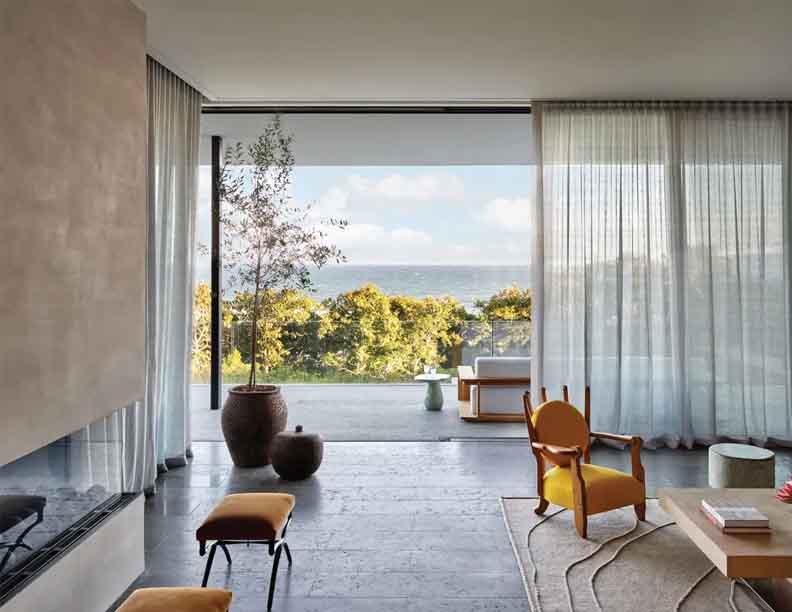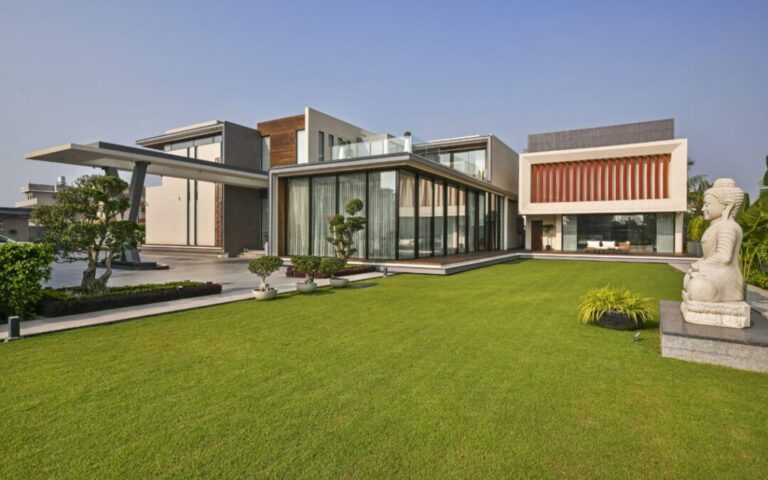Nestled between the Old Montauk Highway and the Atlantic Ocean, this beach house is thoughtfully integrated into the steep, rugged bluff that characterizes this dramatic coastline. Designed by renowned South African architecture firm SAOTA, the residence reflects a commitment to preserving the natural landscape. From the road, the structure remains largely hidden, with only its upper section in view—subtly referencing the local barn vernacular. This design choice grounds the home in Montauk’s architectural tradition while ensuring a low-profile presence that harmonizes with its surroundings.
Referencing the region’s tradition of shingle-clad agricultural structures, the upper volume is wrapped in shou Sugi ban — a timber cladding charred for durability, offering resilience in the coastal environment. Robust and weathered, it provides a protective skin against the Atlantic’s shifting climate and lends the building a grounded, sculptural presence. This dark, textured exterior contrasts with the openness and lightness of the interior spaces, establishing a layered dialogue between protection and exposure, form and experience.
In contrast, the interiors, designed by Rafael de Cárdenas, feel open and luminous. Pale timber finishes and soft tonal shifts reflect the sandy hues of the nearby beach, creating a quiet counterpoint to the darker exterior. This contrast establishes a material dialogue between inside and out — between enclosure and openness, shelter and exposure.
Movement through the home is guided by the natural pull of gravity, beginning at street level through a modest, understated entrance. From there, one descends gradually into the heart of the house. This downward journey is carefully choreographed, revealing framed views of the ocean in stages—a spatial progression that amplifies one’s connection to the surrounding landscape. Positioned higher on the bluff, the main living areas are strategically placed to capture uninterrupted vistas of the Atlantic horizon.
The architecture is composed of three primary elements. A barn-like, timber-clad form houses the entrance, study, and main bedroom. A granite-clad lower level is embedded into the slope, containing guest bedrooms and entertainment areas. Between them, a glazed central element accommodates the kitchen, dining, and living spaces — a transparent core that opens to light and vegetation, allowing the landscape to pass through.

A series of terraced outdoor platforms continues this downward rhythm, stepping from interior to garden, pool, and pool house. The site’s natural descent is echoed in this spatial sequencing, reinforcing the continuity between architecture and earth.
Durability and climate responsiveness guided the use of locally sourced materials, including charred timber and regional stone, chosen for their resilience in the coastal environment. Passive energy strategies — including orientation, natural ventilation, and layered shading — further reduce impact, ensuring the house performs with quiet efficiency over time.
Montauk offers a restrained and grounded response to its environment — a house shaped by movement, by light, and by a deep respect for the land it inhabits.
Source: ARCHITONIC
Lead Designer: SAOTA
Project Team: Mark Bullivant, Kerian Robertson, Alwyn de Vos, Eugene Olivier, Mark Robbins, Marinda Holdstock
Architect Of Record: Cooper Robertson
Interior Designer: Rafael de Cárdenas Contractor: Hobbs Inc
Structural Engineer: Tylin
Landscape Architect: Hollander Design
Lighting Design: Cline Bettridge Bernstein Lighting Design
Photographer: Thomas Loof









